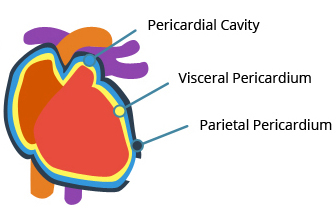What is Malignant Mesothelioma
Mesothelioma Types
There are four types of mesothelioma: Pleural, which attacks the pleural tissue surrounding the long and is the most common form. Peritoneal, which attacks the abdomen and is the second most common type of mesothelioma. Pericardial and tunica vaginalis are also possible forms of the disease and they are very rare. Pericardial attacks the heart and tunica vaginalis attacks the reproductive organs.
Pleural Mesothelioma
Peritoneal Mesothelioma
Pericardial Mesothelioma
Mesothelioma gets its name because of the mesothelium, which is the membrane that surrounds many of the body’s vital organs, and it is where the cancer develops when asbestos is inhaled or ingested.
The form is determined by the location in which the tumor begins, known as its origin site, and the type of cells that the tumor invades, known as its histological subtype. Each type may require a different treatment.
Histological Subtype
The histological subtype refers to the type of cells that the tumors attack:
- epithelioid, which attacks epithelial cells,
- sarcomatoid, which attacks sarcomatous cells, and
- bi-phasic, where the tumor attacks both epithelial and sarcomatous cells.
Mesothelioma and Asbestos
There are approximately 3,000 diagnoses cases of this deadly disease in the United States alone, each year. The only established cause of this cancer is exposure to asbestos, which was used mainly in construction and manufacturing applications through most of the 20th century. Most victims were unwittingly exposed to asbestos at work or while serving in the military. Other victims developed asbestos related cancers due to environmental exposure from loved ones coming home from work with their clothes covered in asbestos fibers. In the United States, asbestos use peaked at 803,000 metric tons in 1973 and then declined to approximately 1,700 metric tons in 2007
Exposure to asbestos is the only confirmed cause of mesothelioma.
One of the most difficult aspects of the disease to come to terms with is its long latency period, which is the period of time between first exposure to asbestos and the onset of the disease. Asbestos related cancers can develop anywhere between 10 to 70 years after the initial exposure.
General Information
Mesothelioma is one of many cancers that are still considered incurable. The tragedy for the victims is that mesothelioma is an entirely preventable disease. This type of cancer attacks the lining of the lungs, chest or abdomen that is highly aggressive and is resistant to many cancer treatments. The disease is associated with exposure to asbestos. Even small amounts of asbestos and infrequent exposure can create a risk for contracting mesothelioma or other asbestos-related diseases.
Many people diagnosed with “asbestos cancer” are retired workers and veterans who inhaled asbestos dust in the workplace or during their military service. Symptoms of asbestos related cancers in those groups typically appear 30 years to 50 years after exposure to asbestos.
Common symptoms of pleural include a persistent cough, constant chest pain, shortness of breath, wheezing or hoarseness, repeated problems with pneumonia or bronchitis, as well as fatigue and weight loss.
Asbestos cancers remain difficult to treat, and new therapies and methods of delivery of medicine are being researched. Chemotherapy and radiation are the primary methods of treatment and may be combined with surgery for patients whose cancer is diagnosed at a less advanced stage. Patients often take part in clinical trials as researchers look for a breakthrough treatment method.
About 3,000 Americans are diagnosed with asbestos related cancers each year. The need to find a cure and viable treatment is so critical that a federal resolution was passed designating National Mesothelioma Awareness Day to be observed in the U.S. each year on September 26.
About The Disease
Types
- Pleural
- Peritoneal
- Pericardial
- Reproductive
- Adenocarcinoma
- Subtypes:
- Lung Cancers:





